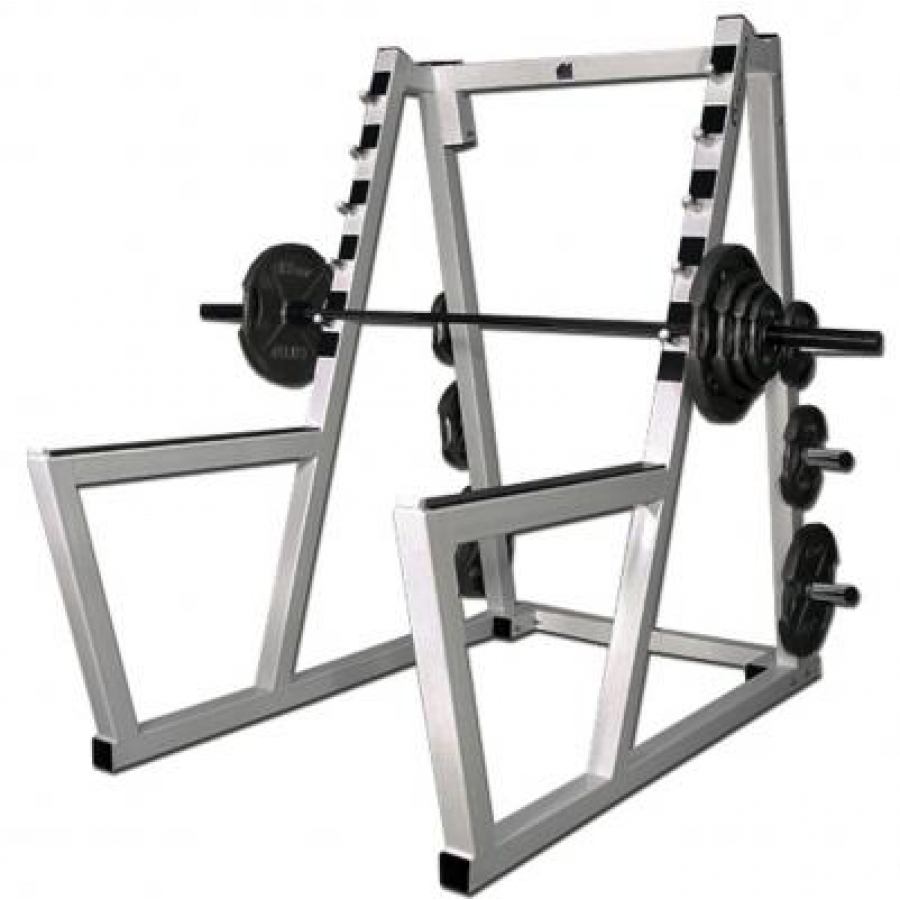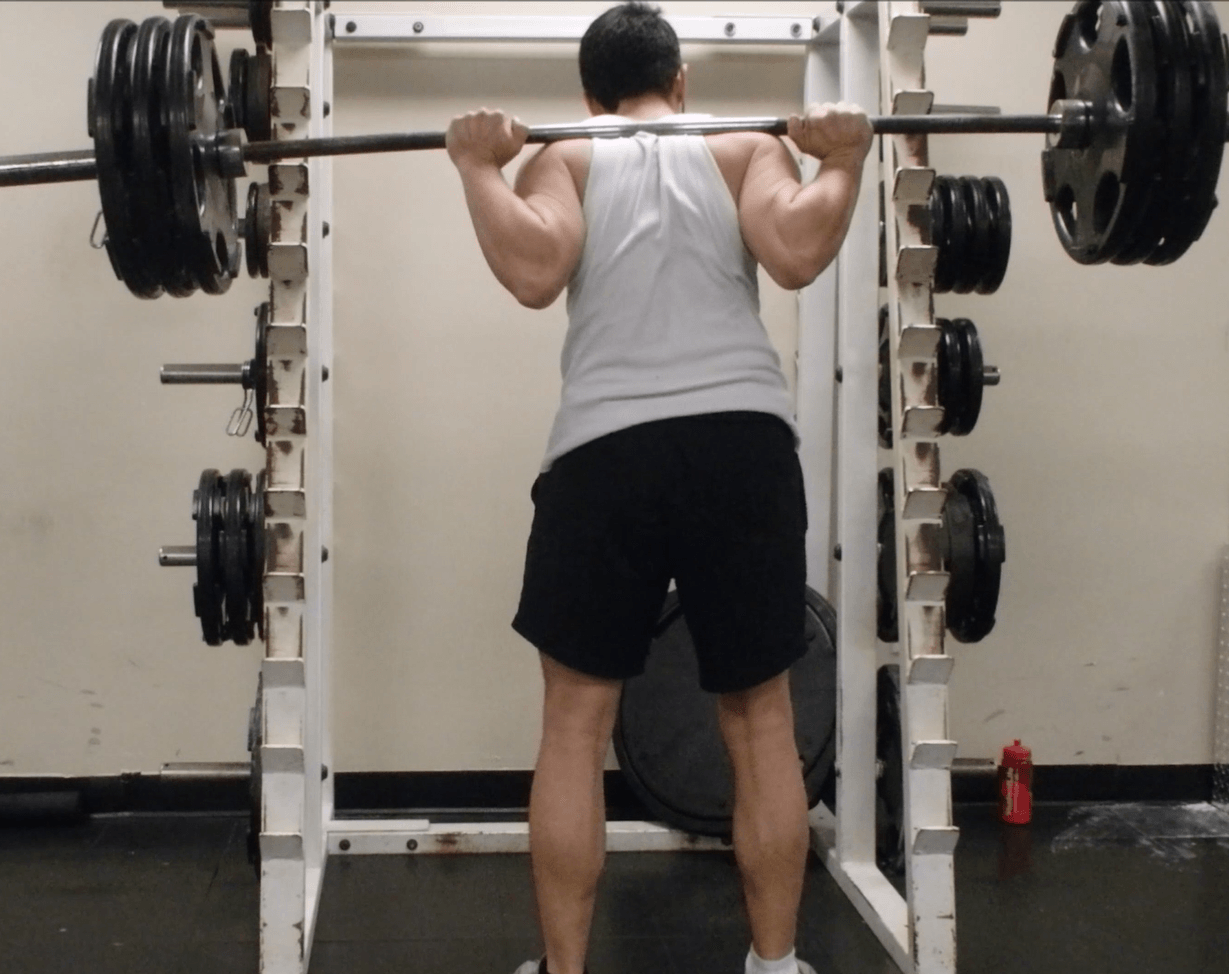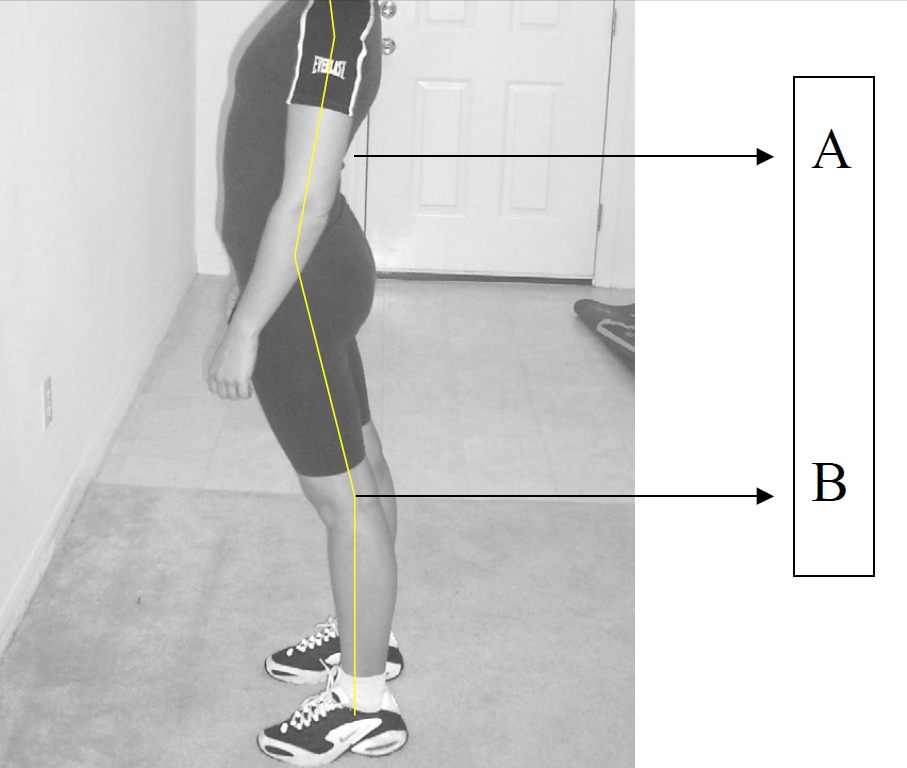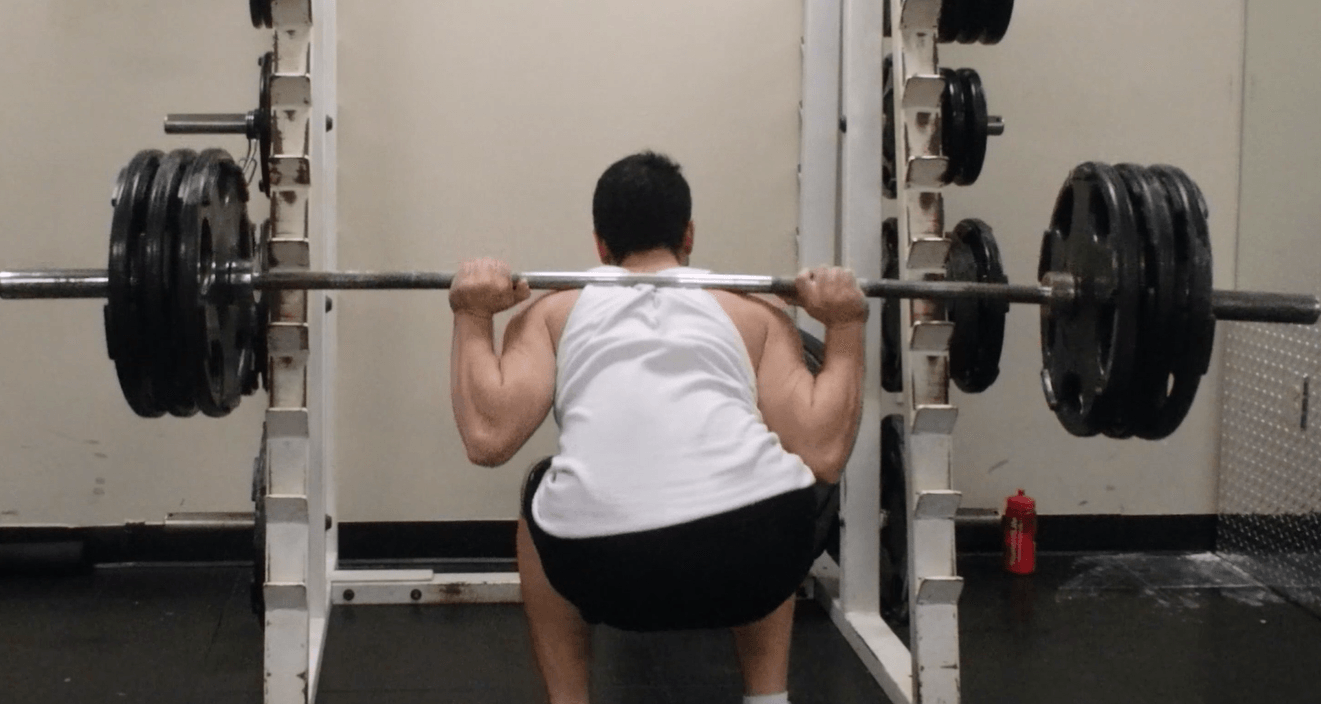Having previously discussed two other lifts in the “big four” series, we will now discuss the squat, arguably the best exercise for the legs, and unarguably a fundamental motion for any athlete or physical culturist. This is because doing the squat properly will not only train the big muscles of the quadriceps, but also the calves, the feet, the buttocks, and the hips.
Combine the squat with the deadlift (which hits the hamstrings much better than the squat), and you’ll never need any other lower body exercises. And it goes without saying that in training your legs, you’ll make yourself run faster, jump higher, punch and kick harder, grapple stronger, and do anything you want to do better.

Squat Variations
Like most exercises worth doing, there are a julienne of variations of the squat. There’s high bar squats, low bar squats, back squats, front squats, overhead squats, pistol squats, and so forth. However, for the majority of lifters, the basic high bar back squat is sufficient for their needs.
To do this exercise, you will need a rack or power cage, preferably the latter as it has safety bars to put the weight down should you be incapable of lifting the weight. To begin, remove the archetypal dudebro doing curls in the squat rack—you’re a man and you’ve got real exercises to do!
Once that’s been done, place the bar in the rack at about shoulder/neck level. Load it with whatever amount of weight you wish.

Then, duck under the bar and then stand up straight, with the bar rest on your trapezius muscles and shoulders—NOT your neck—and gripping the bar with an overhand grip. I understand this might seem a bit confusing, so here is a picture.

The camera was a bit skewed, hence why the picture looks a bit lopsided. My apologies.
Some lifters with a little bit of experience might be asking why I am not using the pad, or that weird ox-yolk thing, or any other sort of device to cushion the weight of the bar against my shoulders. The reason is that I’m not a little girl, and I don’t need to protect my delicate shoulders with a “pussy pad”. Grab the bar, flex your upper back, and suck it up. If your form is right, you don’t need the pad.
Having grasped the bar properly, you must get ready to lift. Get yourself comfortable and place your feet shoulder width apart. Look straight ahead and lock/hollow the back. If that sounds familiar, it should—it’s the exact same preparatory steps you took do for the deadlift. This speaks to the shared muscles these exercises target, and the shared risk for injury should form be improperly done.

This is a textbook image of the medical condition known as hyperlordosis, but as a visual aide I feel it helps people keep their backs in the right position
However, while back injury is a possibility with the squat, the knees and ankles are much more at risk, and will be discussed shortly.
Anyway, keep your feet pointing straight ahead or slightly pointed out. This keeps the knees from pronating inward, which is not something you want to be doing—it weakens the squat and leads to risk of injury.
Begin squatting down in a controlled fashion, while keeping your torso tight and your feet angled properly. Squat down at least until your hips are parallel to your knees, and preferably until your hamstrings touch your calves—or “ass to grass” as the laymen say.
It is through this squatting that the two main risks for injury occur. Should the trainee not squat low enough, he will be bearing weight on his knees rather than the muscles of his legs and glutes, and this can lead to nagging injury outside the gym.

A patella fracture
And in the “ass to grass” squat, a trainee that doesn’t keep his back and hips tight can risk having lower back movement colloquially known as “buttwink” (in actuality a forward tilting of the pelvis at the bottom of the squat), and this can also lead to lower back and hip injury. Luckily, should you already be performing my posture exercises—and really, there’s no reason you shouldn’t be—you should have the hip flexibility to avoid this.

Once you have gone sufficiently low, the actual lift begins. Push hard through the ground (again I recommend doing this barefoot if you can) and straighten out the legs, while keeping your body straight as it should be. Once you’re finished, walk forward and ease the bar onto the rack.
Read More: The Thrust Is A Must (The Importance Of Core Strength)
I tried to do squats but once the weight gets up there, my knees have a lot of pain. My form, according to others, is fine, but I just can’t make it work. I can do a bit better with the deadlift, but I threw my back out a couple times and so I avoid that too.
Have you tried deadlifting with a hexagon bar? It is a more natural function and can probably replace both squats and straight bar deadlift with a hex deadlift.
If you get a lot of knee pain, this may be due to sitting down a lot during the day. Try a sit-stand desk, where you stand for 15 minutes and sit for 45 minutes, and until you get one, make sure you walk around once per hour.
Also, another way to get ripped legs is to play soccer!
I had knee pain too, I think it was my shoes. I was squatting in running shoes when I started for a few months. Knee pain resulted in 6 months off squats. When I got back to squats I wore flat shoes and sometimes no shoes
Initiate the squat, with the hips(not the knees), then let the knees follow. This will go a long way to improving the movement, and avoiding the knee pain.
Use a weight that is comfortable and manageable, until you master the technique. Then add weight. Most people can squat a hell of a lot more weight, with bad form.
For the deadlift, technique again, keep the bar against the shins. shoulders flexed and back, head neutral, chin slightly down. Focus on keeping the lower back safe, throughout the movement. Get the technique down before increasing the weight.
I would also add that a program like Jim Wendlers 5/3/1 is a great program, virtually infallible for getting strong and putting on muscle. I wish I had this book when I started training 30 years ago. I strongly recommend buying his book, most of the stuff written about 5/3/1 on the net glosses over the basics, and has extra stuff added on, that detract from the simplicity and efficiency of the program.
I also trust Arnold when he says “no pain, no gain”. So your legs will only grow when you feel pain. Not pain in your knees of course, so do them slow and don’t bend all the way down
Agreed. This made a big difference dor me. If your abs, legs, biceps etc are not sore the next day, youre not growing.
You need to work on your stabilizers, you likely have glute deficiencies or adductor weakness.
A good test is to see if you can stand on one leg for a minute, five times in a row. Fixing it is simple.
You want to
a) do glute bridges, lie on the ground and raise a bar with your hips. Roll the bar onto a pad to avoid bruising.
b) Loaded lunges, lunge with 50% or less of your max on your back.
c) One legged squats, start with light weight and work up. If stabilizing the bar is difficult, use dumbbells.
As an alternative to deadlift, use a hex bar. It is a superior complex exercise in that it is safer and lets your generate more power by recruiting more muscles. Regular deadlift is a relic kept around for competitions. I also recommend doing loaded carries with the hex bar to further build stabilizers throughout the whole body.
Try sitting back more into the squat. Put more stress on the glutes rather than the knees. Also, consider barbell squats with the bar on the front of your shoulders. However, in the long run I find traditional barbell squats to be shit. Many, many other options exist that avoid spinal compression and other inevitable injuries.
I had this problem as well. Am recovering from it by pressing my knees outwards on the way up. All of the sudden my whole hips were engaged. I went back down to beginners weight cause I realized I had no strength in my hips at all. Now I’m building back up focusing on the hip flexors by pushing my knees out on the way up. The hip muscles stabilize and protect the knees and I can feel a whole new level of strength openimg up. Game changer.
Honestly, the pictures illustrate terrible form. If, as you say, it’s the camera angle, I’d suggest having someone take the photos for you. Alternatively, find photos of the lift being executed properly. Otherwise you are giving a terrible visual image of this excellent exercise.
Agreed. This kids spine is about to snap any day now. Nothing manly about being out of commission or a broke-back-crip.
People with longer legs need to use wider stances. People with shorter torsos may also need to experiment with different bar placements low vs high. Not everyone’s squat stance should be the same. We all have different levers.
That is right. Here is a video explaining a bit differences between people.
Do yourselves a favour and by Mark Rippetoe’s Starting Strength if you want to learn everything there is to know about lifting.
wrists need to be flat, not bent backwards.
have you even mark rippetoe’s starting strength at all?
goes to show you that anyone can have an unqualified opinion and get published on RoK – or any site for that matter.
I respectfully and tentatively disagree about squats and deadlifts being enough…depending on your goals.
If you just want to have a decent body, then doing them will probably place you ahead of the average guy.
If you’re a serious bodybuilder, you need to look deeper.
The calves have only a supporting role in the above mentioned movements and are not taken through their proper range of motion that’s so essential for maximum growth. The tibia muscle or the shin muscle gets even less exercise from deadlifts and squats.
Your hamstrings do need leg curls for complete development and squatting alone will not build proportionate quads; one of the quad heads, rectus femoris, responds poorly to squats and functions as a hip flexor unlike all other quad heads. Studies indicate that leg extensions work the rectus femoris pretty well and some hip flexion exercises may accomplish this as well.
Then there’s the adductors, for which there are specific exercises that ensure that they are getting hit properly as well as opposing exercises for the gluteus medius and minimus muscles, the former of which is visible and allegedly often more developed among women. Squats only work your gluteus maximus, though it is the largest glute muscle.
The anterior tibialis also needs to be worked concentrically rather than just eccentrically. Tibia dorsi flexion, hex bar calf raise and seated calf raise (soleus) is the training I use.
The only way to properly hit your rectus femoris and vastus intermedius on a leg extension is to remove the back rest and tilt to a 30 degree angle. I prefer weighted lunges and sprinting to this, to get the minimus and medius at the same time.
The medius and minimus are activated when raising the leg to the side as you would do in a martial arts side kick. Exercisenet has some good illustrations for proper exercises. The sources I have seen do not indicate that you can train all glute muscles properly doing lunges but I don’t have any certainty.
When I still lifted intensely (I.e., had enough disposable time to focus heavily on lifting & diet), Leg days were monsterous. 25-35 Sets of pretty high weight. I wasn’t “nice” to my legs. People often asked; “Dude, why the hell do you lift your legs so insanely like that?” My response; “You don’t walk around on your hands all day do you?” By lifting your legs heavy, you’ll aid increasing ALL your lifting, not only through untapped testosterone, but shear muscle mass addition. That will ultimately translate into larger upper body, and a waaaay more sturdy frame to support if your whole body is jacked. I always, and I mean every leg day, worked out Quads with squats AND leg press, heavy weighted lunges for glutes, quads, etc, Dead lifts if I didn’t cover them on back-day.., leg extensions, leg curls, aductors, abductors, calves, abs done. Most sets were done so heavy I couldn’t do more than 8-10 reps. If machines were involved, they had additional plates pinned on the rack to overload. Aductors and Abductors will tie in your whole hip and pelvis mechanics that you’ll be able to break through heavier exercises like squatting, pressing, and lunging.
I’d also add, that a sure fire way to screw up your posture, your back, or anything else going outta wack, is lift your legs unevenly. You’re better off lifting a light leg day and hitting most of the muscles, than going heavy squats only.. especially as you age.
Perhaps. But the point is that a very large majority of us (even here at RoK) do not want to be serious bodybuilders. Sure, I’d be happy to have that kind of body, but I simply don’t have the time to spend in the gym to accomplish it, and I guess that the same is true for most people here. I think Larsen’s comment should be read in that context.
Personally, I do squats and deadlifts, and occasionally some leg extensions and lunges. Quick and efficient.
I’d like to add a few things here. Having significant knee issues from past, key discoveries I learned about squatting were 1) Even though the bar is on your traps, and your back/torso are essentially “locked” into position throughout the entire flexion, pretend the bar is actually balanced on the very top of your upper butt, and mentally envision you’re lifting the bar with it balanced on your ass.. which of course it isn’t. THAT tremendously helped me remove my knees from injury during Ass 2 grass squatting, and force me to focus on lifting the weight with hip-focused correction of my squats. You are lifting the weight by driving your butt up. 2) You don’t need to EVER be standing completely straight up, and should actually be slightly bent forward at the hips, maybe 5-7% from start to finish, after all, you have a bar with weight very high center of gravity, too straight and you’ll not only fall backwards with the bar (something I’ve seen occur in my gym during a 435 Lb. squat, very dangerous), this also maintains focus on driving weight with your ass. 3) Don’t look straight forward. Actually, as you squat, let your direct forward view change with your head as you go down and then up. Thus, you start looking mostly straight forward, but as you lower, you’re looking increasingly down towards the floor, then reverse as you go up. I’ve seen many guy who cock their heads back at the bottom, which causes a habit of driving the weight up with their upper quads (which by default get a lot of work anyways), instead of driving up with your butt.
What a bunch of beta orbiters
“the basic high bar back squat is sufficient for their needs.” – NO. this is very bad advice. the low bar squat is what you want to do. it recruits far more of the leg than the high bar, and doing high bar changes the angles and mechanics of the lift completely. high bar is also worse for your knees.
squatting ass to grass is also bad advice. the depth you should squat varies completely from person to person. generally, when you squat down and feel the stretch reflex in your hamstrings, is the depth you should squat to. for some people this might be at or just below parallel, for others it might be lower. once you feel that stretch reflex then initiate the upward part of the lift. squatting lower than you should is also bad for your knees.
this article is just a disaster. terrible advice all round. go and watch some of Mark Rippetoe’s youtube videos on the squat if you want to actually learn how to squat properly. follow the advice in this article if you want to destroy your knees.
First, he does say parallel and “ass to grass” if you can. He could have talked about externally rotating your feet to release the hips, front squat for long torso’s and a dozen other points. This was a fine basic description. You are absolutely correct that watching a squat is far better to reading about it but don’t act like this was completely wrong.
“Some lifters with a little bit of experience might be asking why I am not using the pad, or that weird ox-yolk thing, or any other sort of device to cushion the weight of the bar against my shoulders. The reason is that I’m not a little girl, and I don’t need to protect my delicate shoulders with a “pussy pad”. Grab the bar, flex your upper back, and suck it up.” LOL, literally spit my water. Little experience is the key.
roosh is brainwash with severe homofobia. i want more woman in workforce and army because too many men. i dont like go to skool. feminism is for everbody. teech men not raep. herry potter is best bouk in liberry. soy is good for heart. hamburger is murdur. all woman must cut hair short for equal treatment and better world.
Wow much true
Your squat form is horrific.
Squats among other lifts are predominantly optimized by generating torque withe either your legs or wrists depending on the lift and corkscrewing loaded weight into position with a tightened base. The Supple Leopard by Kelly (forgot last name) is a great book for learning how to lift properly. The guy know his stuff.
The Supple Leopard is gibberish. Starting Strength by Rippetoe is THE authority on the subject. That is all.
HOW TO INJURE YOURSELF 101. –Idiot cuck fucking losers!
Great video of Mark Rippetoe teaching the low bar squat:
Also, the buttwink issue can be resolved by looking downwards:
Edit to the above: I meant this for the buttwink video
Parallel squats lead to sore knees. Notice the M. Rippetoe method advises toes out, and ass-to-grass. IMO Parallel squats can only get to ‘half squat’ depth, I’ve never seen a parallel squat go deep and I don’t think it’s possible.
I defer to “Starting Strength” by M. Rippetoe in all matters.
A couple extra suggestions: I can squat more weight easier if I look down a yard in front of my feet instead of looking ahead. The downside for some might be that you can’t check your form in the mirror, but this way works better for me. I also suggest taking a deep breath and holding it before you go down and continue to hold it as you come back up.